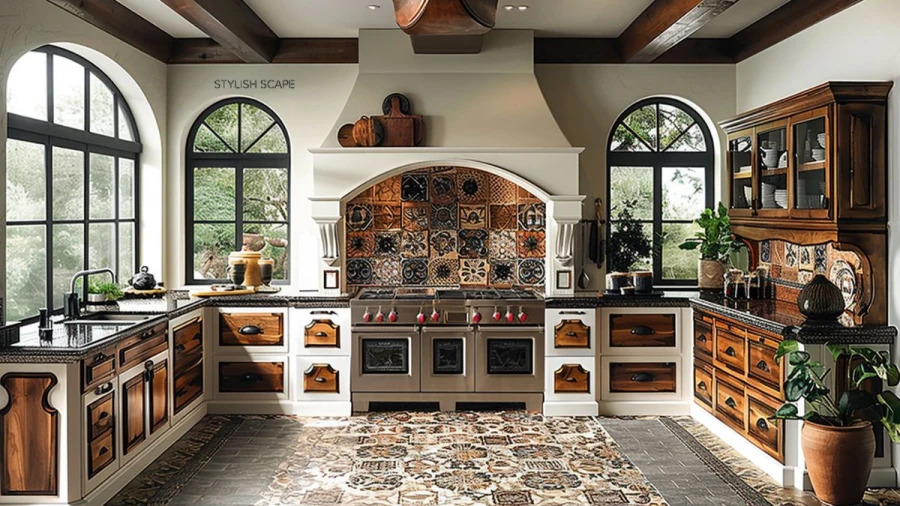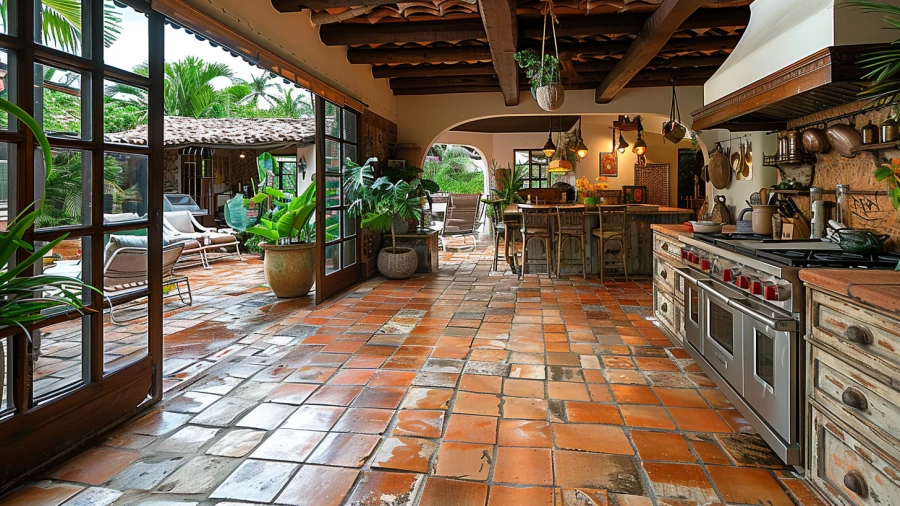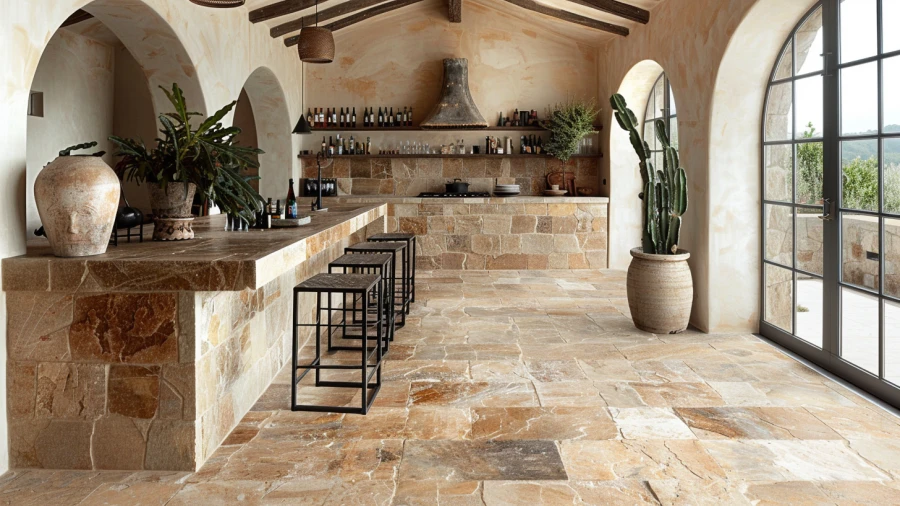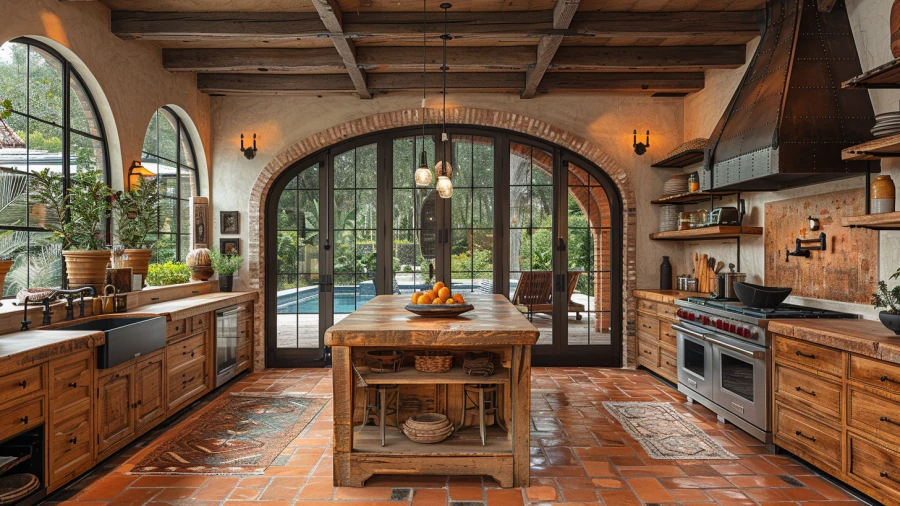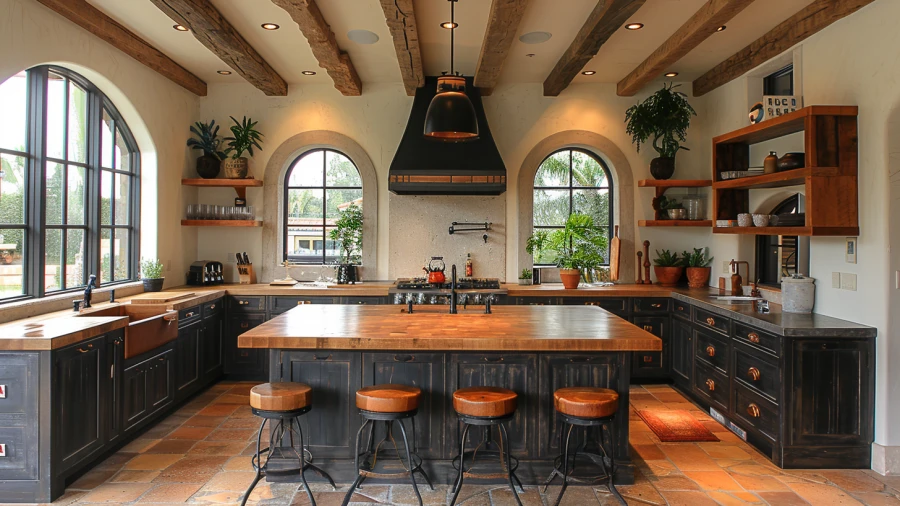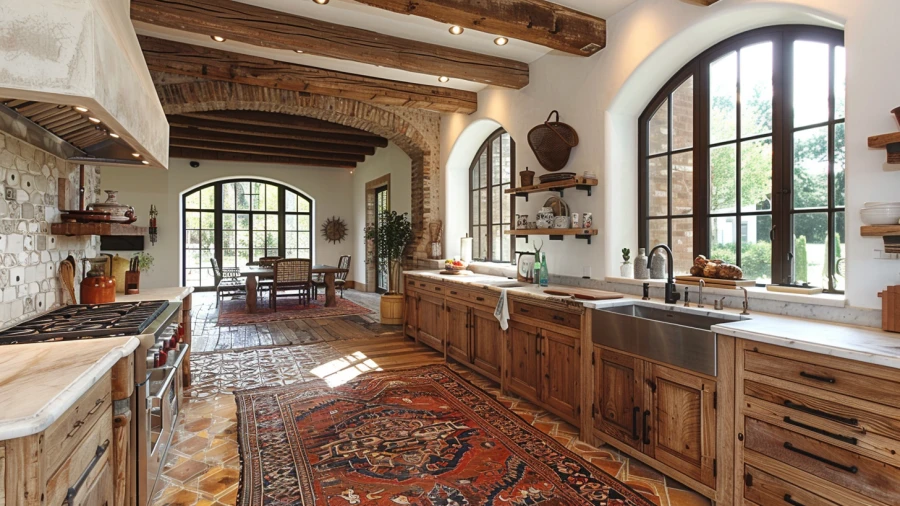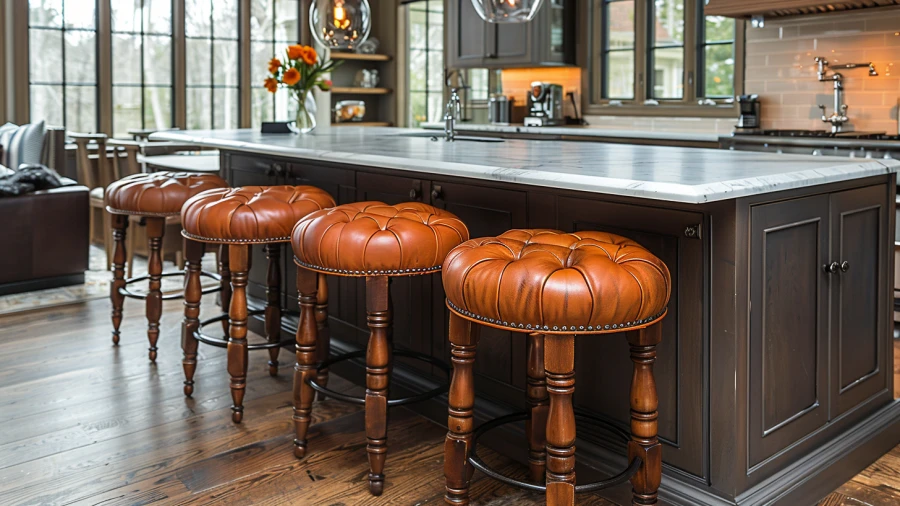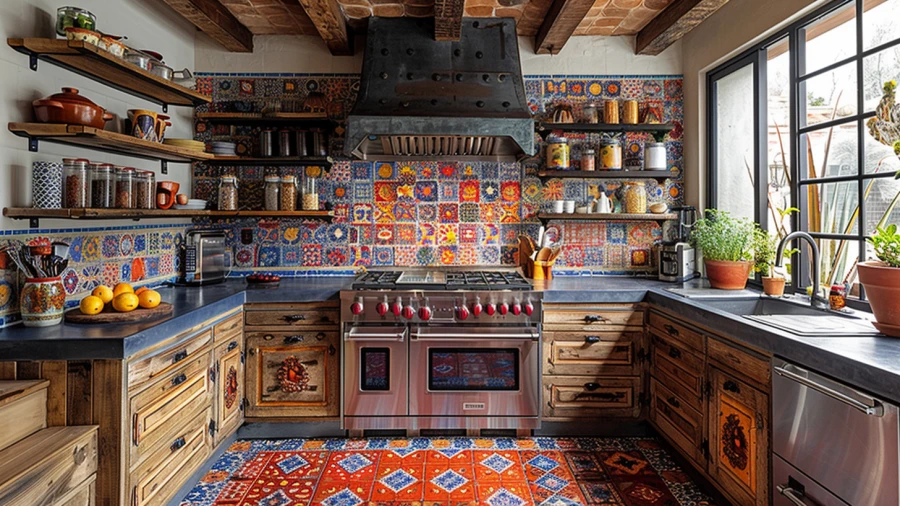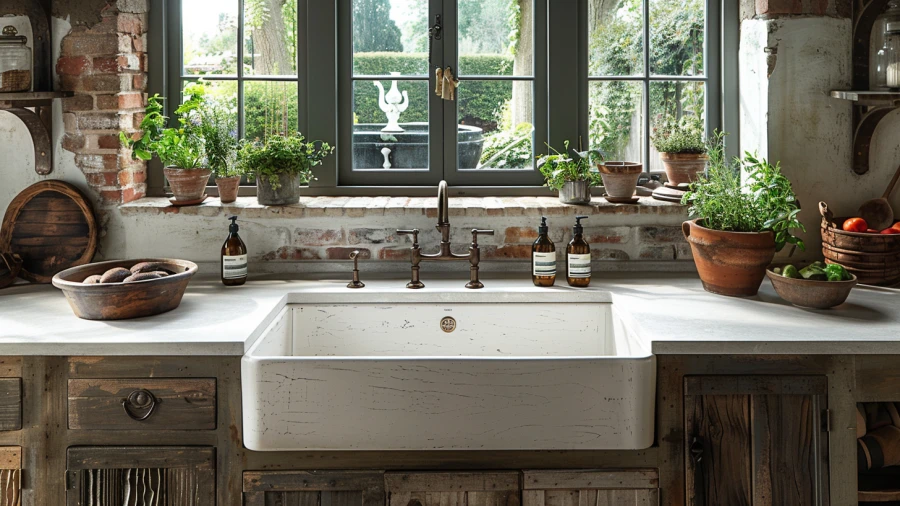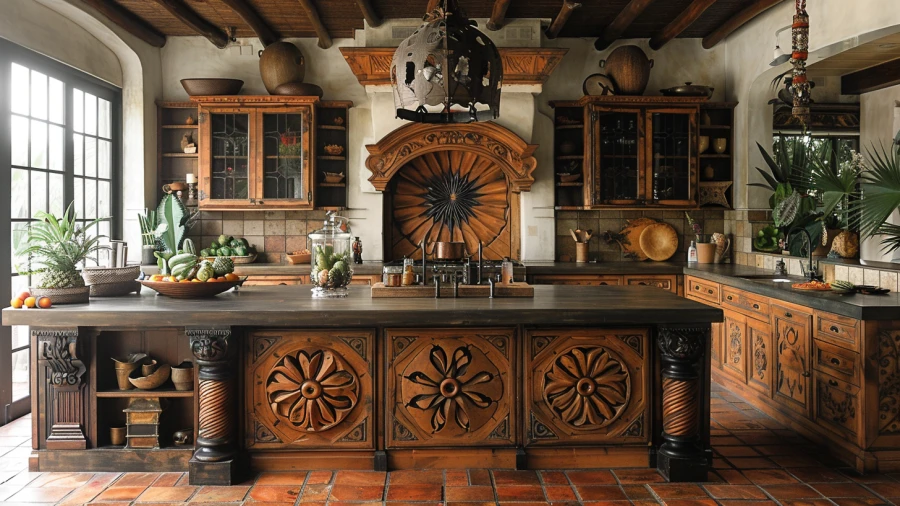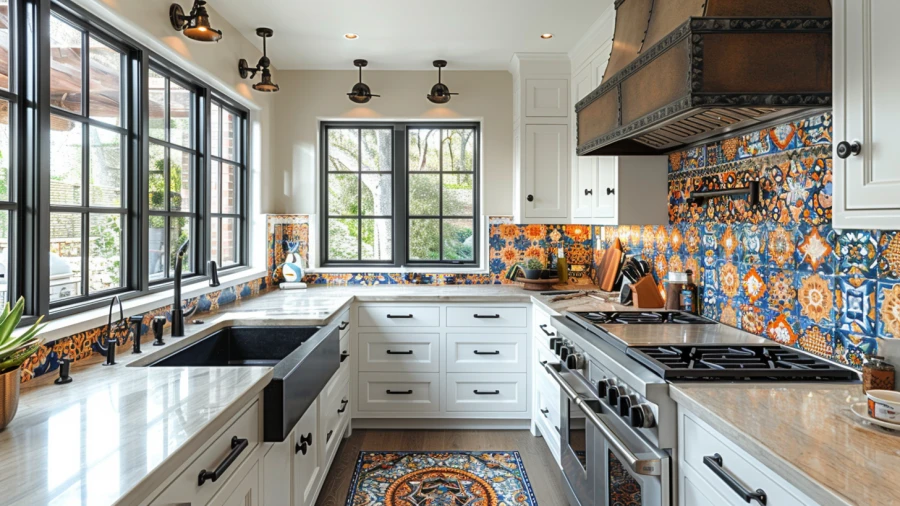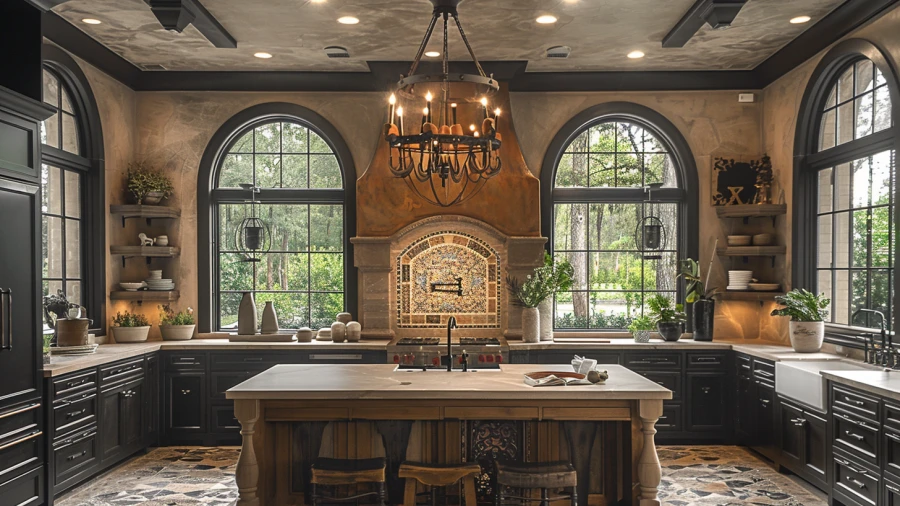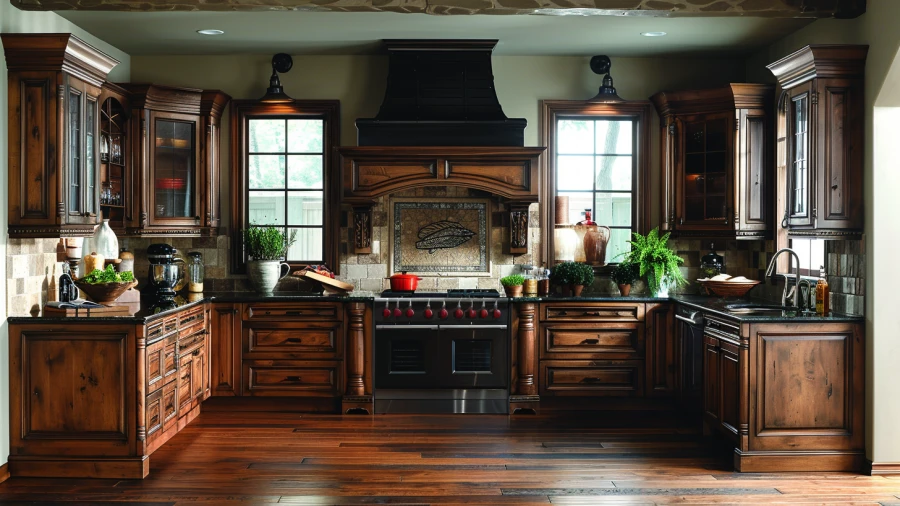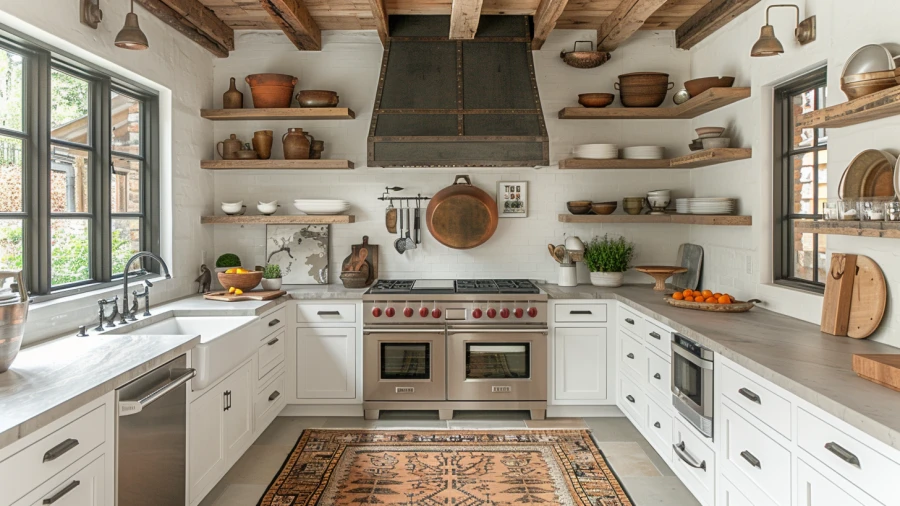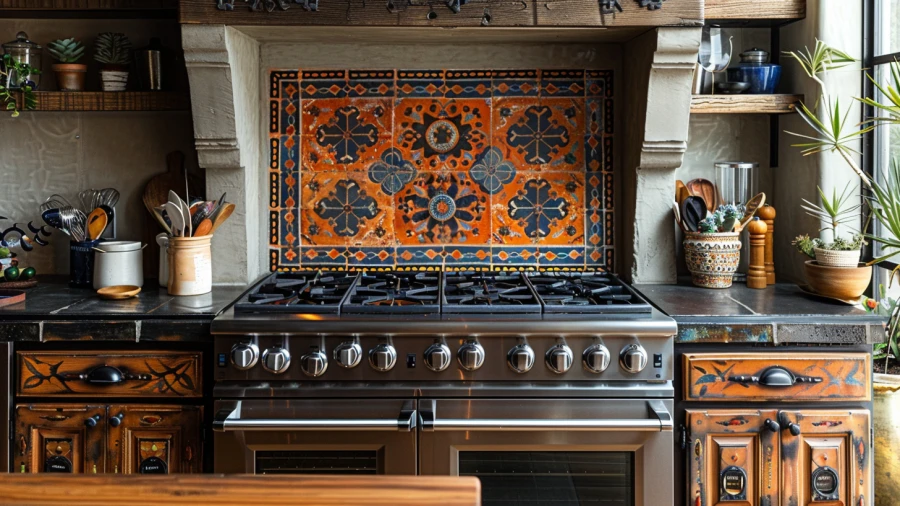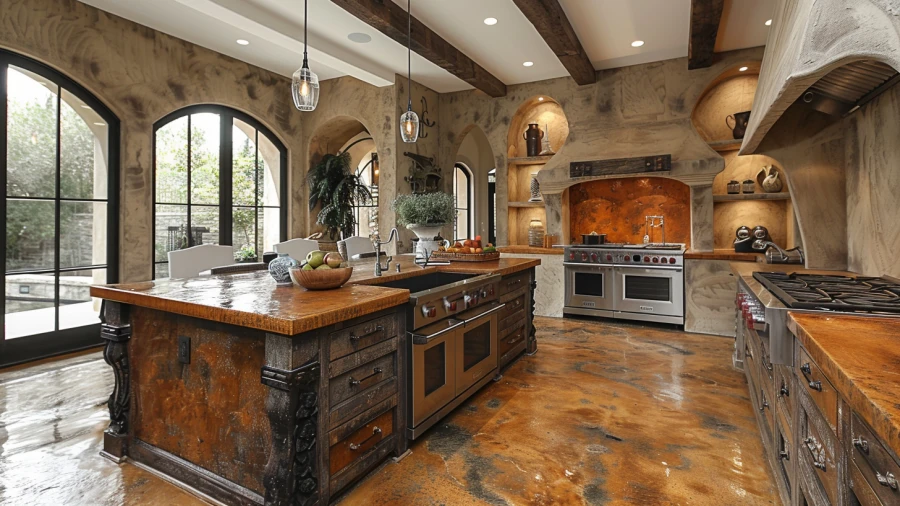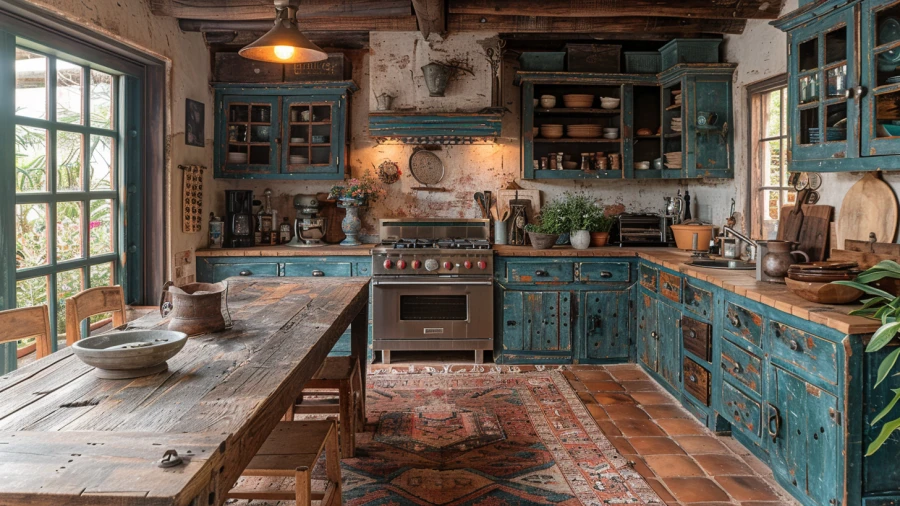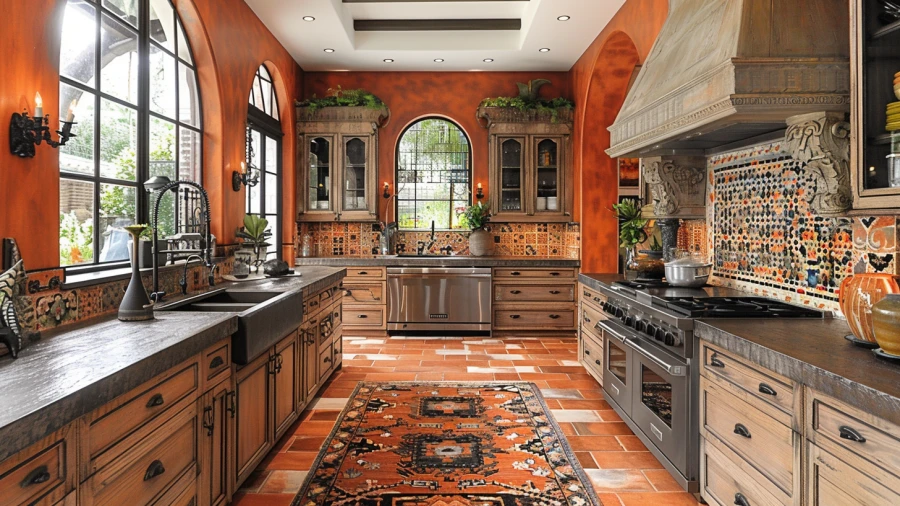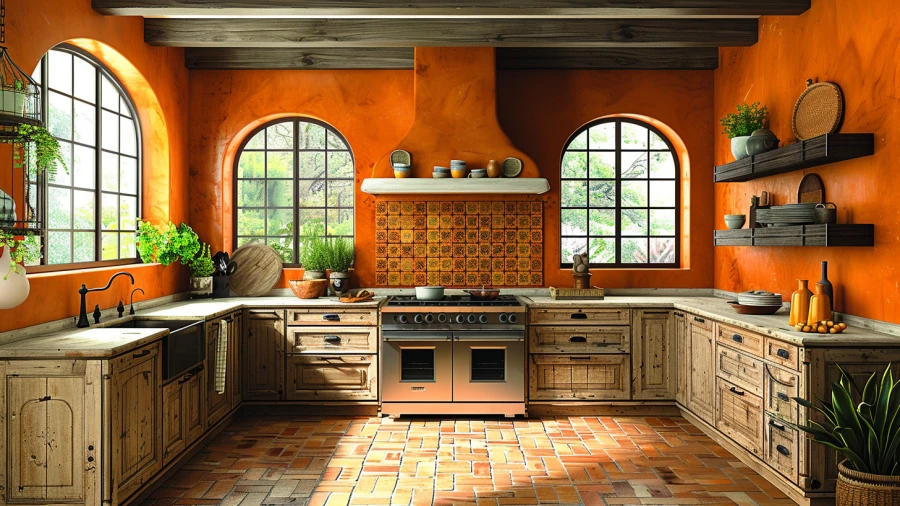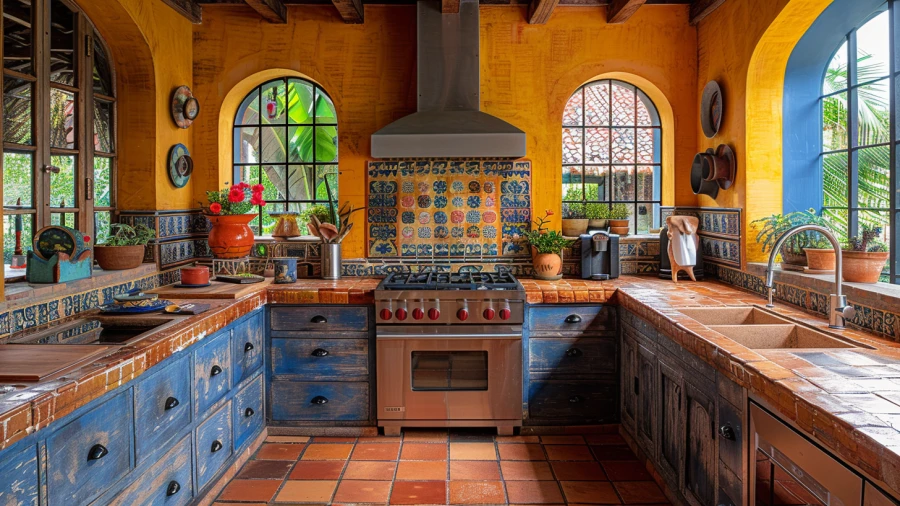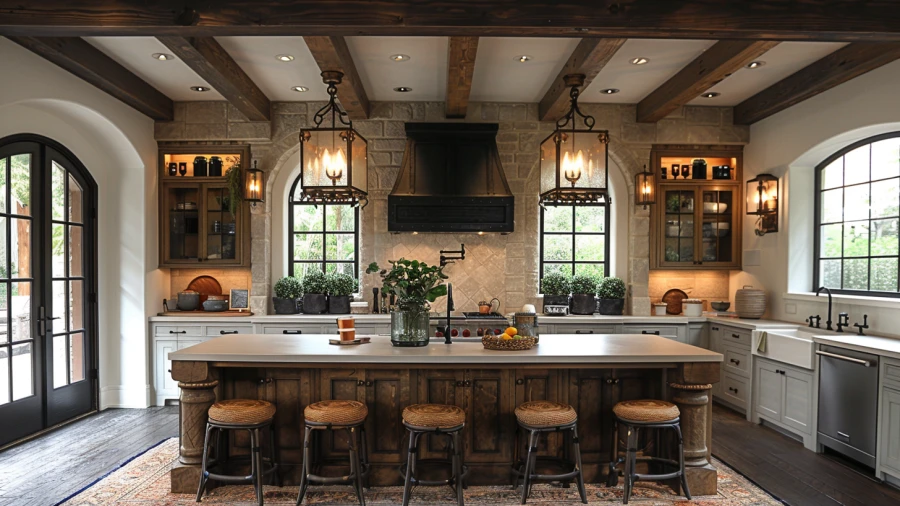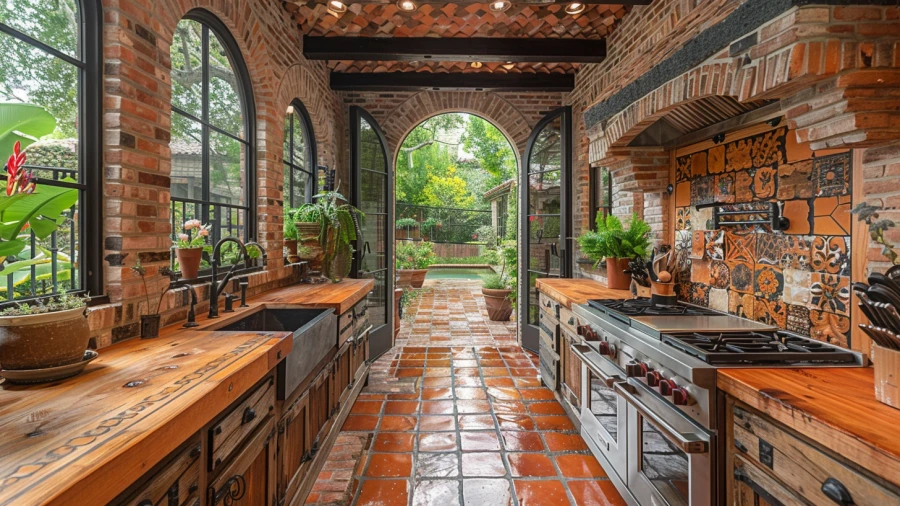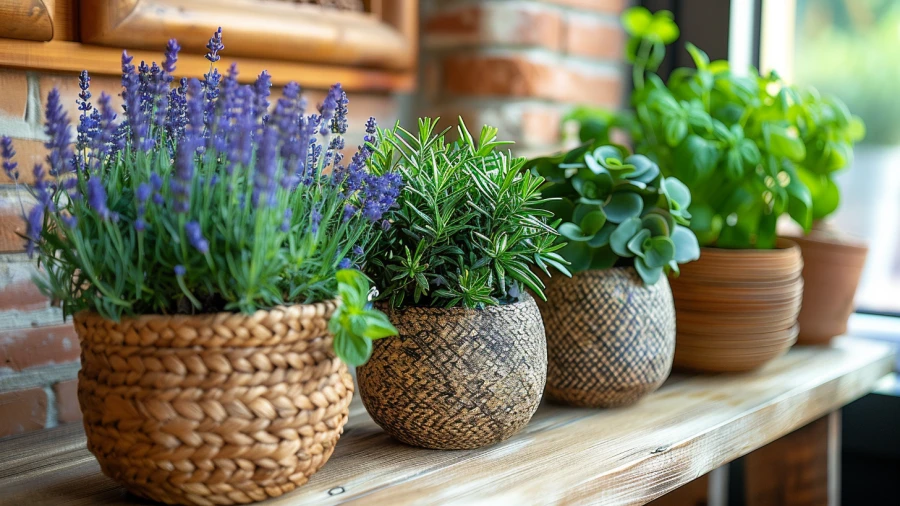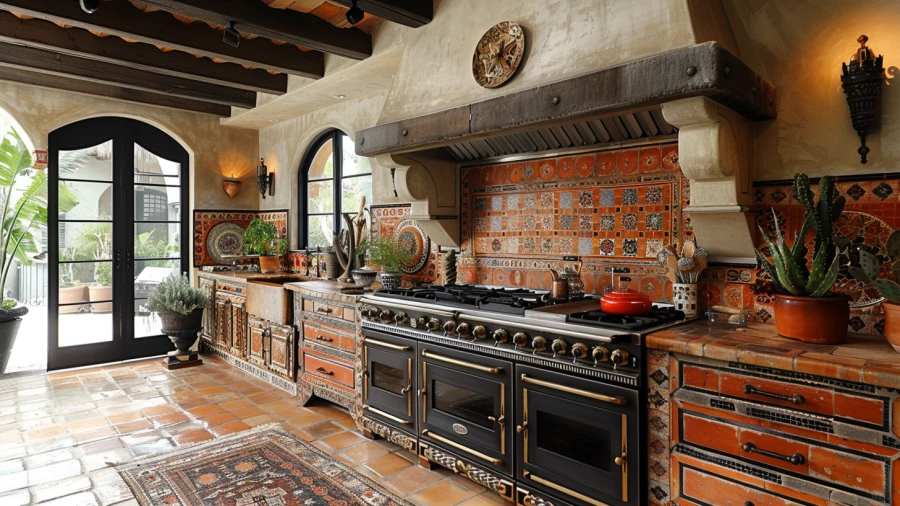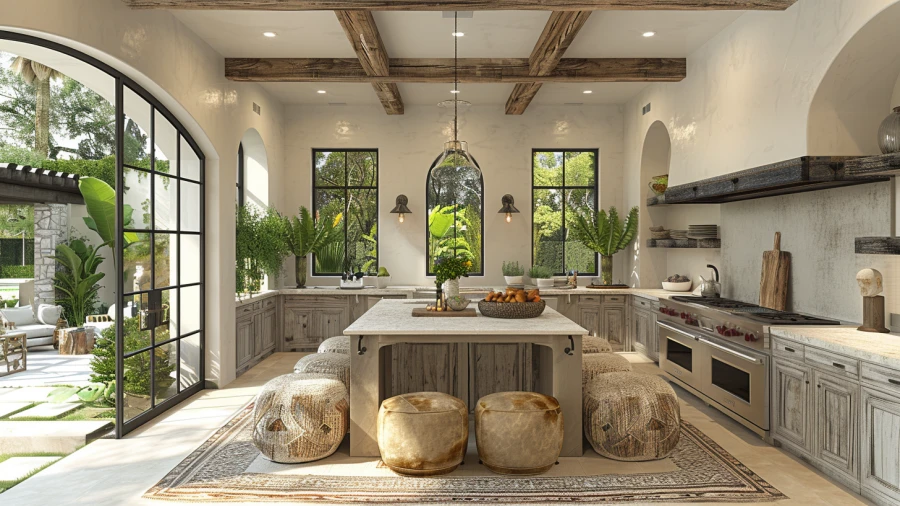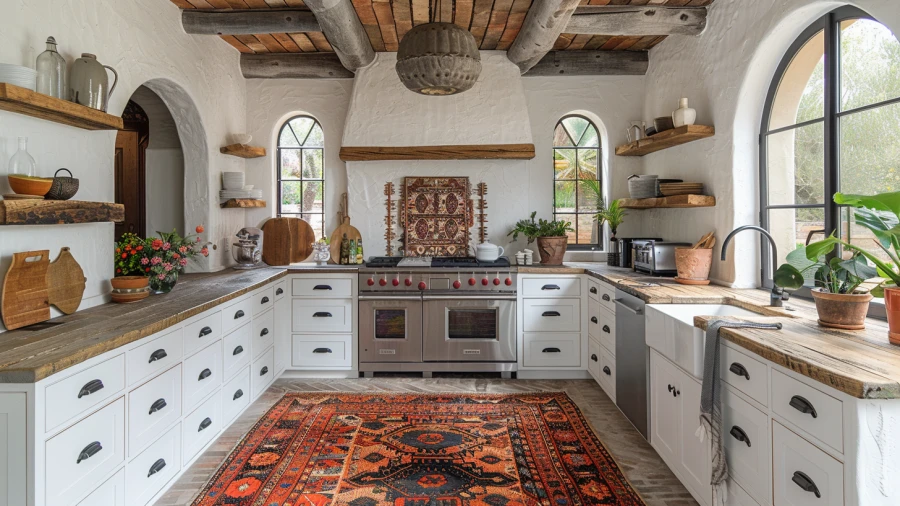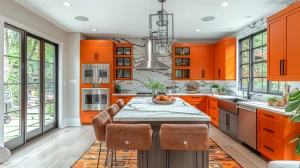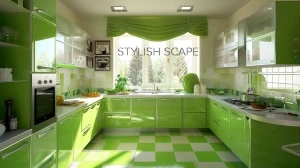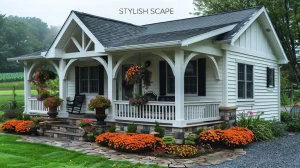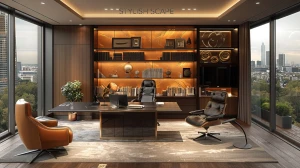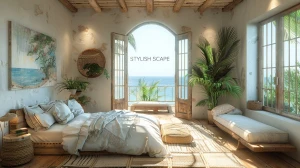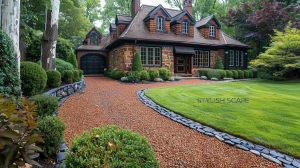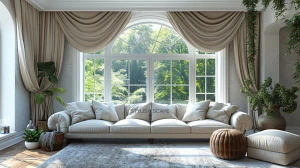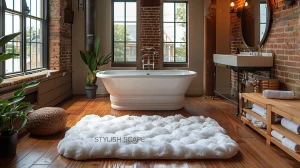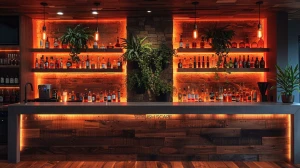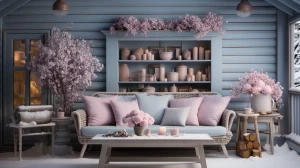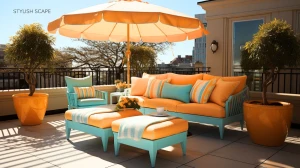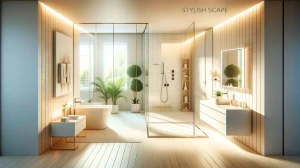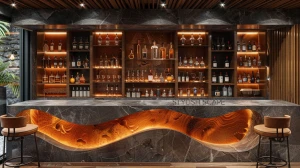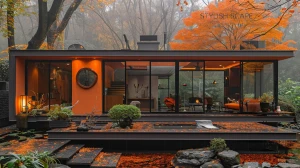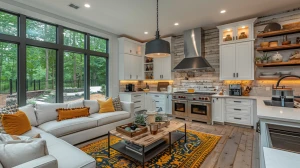
25 Modern Spanish Style Kitchen Ideas to Spark Your Design Creativity
Find inspiration in Spanish-style kitchen ideas that showcase terracotta flooring, arched doorways, vibrant tile patterns, and rustic wooden beams. Spanish kitchens blend traditional Old World charm with modern features, creating stylish and inviting spaces.
by Priyanka P
Updated Sep 03, 2024
On This Page
- Spanish Style Kitchen Ideas
- Terracotta Flooring for a Spanish Kitchen
- Natural Stone Floors Kitchen
- Arched Doorways and Windows Spanish Kitchen
- Beamed Ceilings Spanish Style Kitchen
- Exposed Wooden Beams Spanish Style Kitchen
- Leather Bar Stools
- Spanish Style Kitchen With Vibrant Tile Patterns
- Farmhouse-Style Sinks
- Hand-Carved Spanish Kitchen
- Mosaic Tile Accents For a Spanish Kitchen
- Rustic Iron Chandeliers Spanish Style Kitchen
- Rich Wooden Cabinetry
- Spanish Kitchen With Open Shelving Displays
- Decorative Tile Backsplashes
- Textured Stucco Walls in Spanish Style Kitchen
- Vintage Furniture Kitchen
- Wrought Iron Hardware for Spanish Style Kitchen
- Spanish Earthy Heritage Tones
- Cheerful Colors in Spanish Kitchen
- Spanish Iron Light Fixtures Kitchen
- Rustic Counter Surfaces in Spanish Style Kitchen
- Mediterranean Potted Plants
- Decorative Oven Hoods for Spanish Kitchen
- Seamless Open Layout
- Patterned Rugs and Textiles in Spanish Kitchen
- What Types of Lighting Are Suitable For a Spanish Style Kitchen?
Spanish Style Kitchen Ideas
A Spanish-style kitchen is known for its warm, inviting look and traditional details. It often features earthy colors like terracotta reds and warm browns. Key elements include arched doorways, exposed wooden beams, and vibrant, patterned tiles. These Spanish kitchens might have rustic touches such as hand-carved wooden cabinets and wrought iron hardware.
Flooring can be made from natural materials like terracotta or stone, adding to the rustic charm. Bright, cheerful colors and decorative accents, like intricate oven hoods and iron light fixtures, help to create a lively and welcoming atmosphere. Open layouts are common, connecting the kitchen to other living areas for a spacious feel. Mediterranean potted plants and patterned textiles add a touch of nature and style.
Terracotta Flooring for a Spanish Kitchen
Terracotta flooring is a quintessential feature in Spanish-style kitchens, offering a warm, earthy foundation that complements Mediterranean decor. This type of flooring is made from clay and is known for its durability and distinctive, rustic appearance. Terracotta tiles often come in natural, muted colors like reds, oranges, and browns, enhancing the cozy, inviting atmosphere of a Spanish kitchen.
They also age beautifully, developing a unique patina over time that adds to their charm. In addition to their aesthetic appeal, terracotta floors are practical, providing excellent insulation and easy maintenance. Their natural texture and color variations contribute to the authentic, handcrafted look typical of Spanish-style interiors.
Natural Stone Floors Kitchen
Natural stone floors are a classic choice for Spanish-style kitchens, known for their durability and timeless elegance. Materials such as travertine, limestone, and slate offer a rugged yet refined look that aligns perfectly with Mediterranean aesthetics. The unique veining and textures of natural stone add character and depth to the kitchen space.
Stone flooring also provides excellent thermal mass, helping to keep the kitchen cool in hot weather, which is ideal for the warmer climates where Spanish-style homes are often found. Regular sealing is required to maintain the stone’s appearance and longevity, but the investment pays off with a stunning and enduring flooring option that enhances the overall ambiance of a Spanish kitchen.
Arched Doorways and Windows Spanish Kitchen
Arched doorways and windows are defining features of Spanish kitchens, adding an element of classic charm and architectural interest. These arches often serve as focal points in the room, creating a sense of grandeur and continuity with traditional Spanish architecture. The curves of the arches soften the lines of the space, contributing to a more fluid and inviting atmosphere.
In a Spanish kitchen, arched doorways can lead to other areas of the home, such as dining or living spaces, while arched windows frame picturesque views and allow natural light to flood the room. This design element not only enhances the aesthetic appeal but also aligns with the historical roots of Spanish-style architecture.
Beamed Ceilings Spanish Style Kitchen
Beamed ceilings are a hallmark of Spanish-style kitchens, adding both visual interest and a sense of warmth. These ceilings are often constructed from exposed wooden beams that can be left in their natural state or stained to enhance their rich, rustic appearance. The beams create a dramatic architectural element, drawing the eye upward and making the space feel more expansive.
In Spanish kitchens, beamed ceilings evoke a traditional, old-world charm that complements other elements like terracotta flooring and rustic cabinetry. The use of wood in the ceiling contrasts beautifully with the surrounding materials, contributing to a balanced and cohesive design.
Exposed Wooden Beams Spanish Style Kitchen
Exposed wooden beams are a key feature in Spanish-style kitchens, offering a touch of rustic elegance and historical authenticity. These beams can be made from a variety of woods, including oak or pine, and are often left in their natural state or lightly finished to highlight their grain and character. The presence of exposed beams adds a sense of warmth and grandeur to the kitchen, enhancing its Mediterranean feel.
They also create a visual link to traditional Spanish architecture, where wooden beams were commonly used in construction. Whether used in an old-world farmhouse or a modern adaptation, exposed beams provide a timeless and inviting element to Spanish-style interiors.
Leather Bar Stools
Leather bar stools are a stylish and practical addition to a Spanish-style kitchen, combining comfort with sophistication. The rich, textured appearance of leather complements the warm, earthy tones typical of Spanish decor. These stools often feature traditional details like nailhead trim or carved wooden legs, which align with the rustic and handcrafted aesthetic of Spanish interiors.
Leather is durable and easy to maintain, making it a suitable choice for high-use areas like kitchen islands or breakfast bars. The natural aging process of leather also adds to its charm, enhancing the overall character of the Spanish-style kitchen as the stools develop a unique patina over time.
Spanish Style Kitchen With Vibrant Tile Patterns
Vibrant tile patterns are a signature element of Spanish-style kitchens, infusing the space with color and personality. These tiles often feature intricate designs and bold colors, including blues, reds, and yellows, which reflect the rich cultural heritage of Spain. Decorative tiles can be used in various ways, such as on backsplashes, flooring, or as accents throughout the kitchen.
The patterns range from geometric shapes to traditional motifs, adding visual interest and a touch of artistic flair. The use of vibrant tiles not only enhances the aesthetic appeal but also ties together other design elements, creating a cohesive and lively Spanish-style kitchen.
Farmhouse-Style Sinks
Farmhouse-style sinks are a popular choice in Spanish-style kitchens, blending functionality with classic charm. Characterized by their deep basins and front-facing apron, these sinks offer ample space for washing large pots and pans, making them both practical and aesthetically pleasing. The traditional design of a farmhouse sink complements the rustic and timeless elements of Spanish decor.
Materials such as ceramic, copper, or natural stone are commonly used, each adding a distinct character to the kitchen. The exposed front of the sink becomes a focal point, contributing to the overall warmth and authenticity of the Spanish-style kitchen.
Hand-Carved Spanish Kitchen
Hand-carved cabinet details are a hallmark of Spanish-style kitchens, adding a touch of artisanal craftsmanship and elegance. These details often include intricate designs, such as floral motifs or geometric patterns, carved directly into the wood of the cabinets. This level of craftsmanship reflects the traditional woodworking techniques used in Spanish architecture and decor.
Hand-carved elements bring a sense of history and artistry to the kitchen, making each piece unique. The rich textures and designs of these cabinet details complement other Spanish-style features, such as exposed wooden beams and terracotta flooring, creating a cohesive and inviting space.
Mosaic Tile Accents For a Spanish Kitchen
Mosaic tile accents are a versatile and visually striking feature in Spanish-style kitchens. These tiles are often used to create decorative patterns or borders on backsplashes, floors, or walls, adding a splash of color and texture to the space. Mosaic designs can range from intricate traditional patterns to modern interpretations, allowing for a wide range of aesthetic choices.
The reflective surfaces of mosaic tiles also enhance light within the kitchen, making the space feel brighter and more open. Incorporating mosaic accents helps to achieve a distinctive and personalized Spanish-style kitchen, providing both functional and decorative benefits.
Rustic Iron Chandeliers Spanish Style Kitchen
Rustic iron chandeliers are a defining feature of Spanish-style kitchens, offering a blend of functionality and dramatic flair. These chandeliers often feature ornate, wrought iron designs that complement the traditional and rugged elements of Spanish decor. The use of iron in the chandelier provides a robust, industrial touch that contrasts beautifully with warmer materials like wood and terracotta.
Rustic iron chandeliers come in various styles, from simple and understated to intricate and elaborate, allowing you to choose one that best fits the ambiance of your kitchen. The warm glow from these chandeliers adds to the inviting atmosphere of the Spanish-style kitchen.
Rich Wooden Cabinetry
Rich wooden cabinetry is a key element in Spanish-style kitchens, providing a sense of warmth and tradition. The cabinetry often features deep, rich finishes such as mahogany, oak, or walnut, which complement the earthy tones and rustic details of Spanish decor. Wooden cabinets may include intricate carvings or traditional hardware, enhancing their visual appeal and reflecting the craftsmanship of Spanish design.
The use of wood in cabinetry adds depth and texture to the kitchen, creating a timeless and elegant space that aligns with the Mediterranean aesthetic. Proper care and maintenance of wooden cabinets ensure their longevity and enduring beauty.
Spanish Kitchen With Open Shelving Displays
Open shelving displays are a popular feature in Spanish kitchens, offering both practical storage and aesthetic appeal. These shelves allow for the display of beautiful Spanish ceramics, glassware, and other kitchen essentials, adding a personal touch to the space. Open shelving creates a more open and airy feel, making the kitchen feel larger and more inviting.
The ability to showcase carefully curated items also contributes to the overall decor, tying together the traditional and rustic elements of Spanish design. To maintain a cohesive look, consider arranging items by color or style and incorporating decorative elements like plants or artwork.
Decorative Tile Backsplashes
Decorative tile backsplashes are a standout feature in Spanish-style kitchens, adding color, texture, and pattern to the space. These backsplashes often feature intricate designs and vibrant colors that reflect traditional Spanish tilework. Common motifs include geometric patterns, floral designs, or hand-painted tiles that provide a focal point above countertops and cooking areas.
Decorative tile backsplashes not only enhance the visual appeal but also protect walls from splashes and spills. The combination of functionality and artistry makes these backsplashes a key element in achieving the authentic and lively ambiance of a Spanish-style kitchen.
Textured Stucco Walls in Spanish Style Kitchen
Textured stucco walls are a hallmark of Spanish-style kitchens, contributing to the rustic and warm atmosphere of the space. Stucco, a plaster-like material applied to walls, creates a textured surface that adds depth and character. This finish can be smooth or rough, depending on the desired look, and is often left in its natural, earthy color or painted in warm, neutral tones. The texture of stucco walls enhances the traditional Mediterranean charm of the kitchen while also providing a durable and low-maintenance surface. Incorporating stucco into your Spanish-style kitchen adds a distinctive touch that aligns with classic architectural elements.
Vintage Furniture Kitchen
Vintage furniture pieces add a unique and authentic touch to Spanish-style kitchens, blending seamlessly with traditional design elements. These pieces, often characterized by intricate carvings, distressed finishes, or ornate details, bring a sense of history and character to the space. Vintage furniture can include items such as antique dining tables, wooden chairs, or decorative cabinets, each contributing to the overall charm of the kitchen.
By mixing vintage pieces with other Spanish-style elements like terracotta flooring and exposed beams, you create a cohesive and inviting environment that celebrates both old-world craftsmanship and contemporary comfort.
Wrought Iron Hardware for Spanish Style Kitchen
Wrought iron hardware is a classic feature in Spanish-style kitchens, adding a touch of rustic elegance and functionality. This hardware, which includes items such as handles, hinges, and knobs, is typically crafted from heavy-duty iron and may feature intricate designs or simple, robust shapes. The dark, matte finish of wrought iron contrasts beautifully with wooden cabinetry and other warm materials, enhancing the traditional Spanish aesthetic.
This durable hardware not only provides practical benefits but also contributes to the overall character and charm of the kitchen, making it an essential element in achieving a cohesive Spanish-style design.
Spanish Earthy Heritage Tones
Earthy heritage tones are fundamental to the color scheme of Spanish-style kitchens, creating a warm and inviting atmosphere. These tones, which include rich browns, terracotta reds, and muted ochres, reflect the natural colors found in Mediterranean landscapes. Using these hues in walls, flooring, cabinetry, and accents helps to evoke the timeless, rustic charm of Spanish design.
Earthy tones also pair well with other traditional elements, such as wrought iron hardware and patterned tiles, contributing to a cohesive and authentic look. The use of these colors ensures that the kitchen feels both grounded and elegant, embodying the spirit of Spanish-style decor.
Cheerful Colors in Spanish Kitchen
Bright, cheerful colors are a hallmark of Spanish-style kitchens, adding vibrancy and energy to the space. These colors often include bold hues such as sunny yellows, deep blues, and lively reds, reflecting the lively and spirited nature of Spanish design. Incorporating these colors through tiles, wall paint, or decorative accents creates a dynamic and welcoming environment.
Bright colors can be used to highlight architectural features like arched doorways or to complement other traditional elements such as terracotta flooring and wooden beams. This infusion of color enhances the overall ambiance of the kitchen, making it both lively and inviting.
Spanish Iron Light Fixtures Kitchen
Iron light fixtures are a distinctive feature in Spanish-style kitchens, providing both illumination and a touch of rustic elegance. These fixtures, often crafted from wrought iron, come in various designs, from elaborate chandeliers to simple pendant lights. The dark, matte finish of iron contrasts beautifully with the warm tones of wooden cabinetry and terracotta flooring, enhancing the traditional Spanish aesthetic.
Iron light fixtures not only contribute to the kitchen's visual appeal but also offer practical lighting solutions. The robust and decorative nature of these fixtures adds character and a sense of historical charm to the space.
Rustic Counter Surfaces in Spanish Style Kitchen
Rustic counter surfaces are a defining feature of Spanish-style kitchens, offering both practical benefits and aesthetic appeal. Materials such as granite, butcher block, or reclaimed wood are commonly used, each providing a textured, natural look that complements the warm, earthy tones of Spanish decor. Rustic counters are durable and can handle the rigors of a busy kitchen while adding a touch of rugged elegance.
The natural imperfections and variations in these surfaces contribute to the overall charm and authenticity of the Spanish-style kitchen, creating a space that feels both welcoming and timeless.
Mediterranean Potted Plants
Mediterranean potted plants are a popular addition to Spanish-style kitchens, bringing a touch of greenery and freshness to the space. These plants, which include options like olive trees, lavender, and succulents, thrive in the warm, sunny environment typical of Spanish kitchens. Potted plants can be placed on countertops, windowsills, or open shelves, adding a natural element that complements the traditional decor.
The presence of greenery enhances the overall ambiance, making the kitchen feel more vibrant and inviting. Incorporating Mediterranean plants into your kitchen design not only adds visual interest but also contributes to a calming and refreshing atmosphere.
Decorative Oven Hoods for Spanish Kitchen
Decorative oven hoods are a key feature in Spanish-style kitchens, combining functionality with aesthetic appeal. These hoods often feature intricate designs and finishes, such as wrought iron, hand-painted tiles, or ornate carvings, making them a focal point in the kitchen.
The decorative elements of the oven hood can complement other design features, such as beamed ceilings and vibrant tile patterns, enhancing the overall Spanish-style aesthetic. A well-designed oven hood not only improves ventilation but also adds a touch of elegance and traditional charm to the kitchen, making it a standout feature in Spanish-style decor.
Seamless Open Layout
A seamless open layout is a desirable feature in Spanish-style kitchens, creating a fluid and interconnected space that enhances both functionality and comfort. This layout often integrates the kitchen with adjacent dining or living areas, promoting a sense of openness and flow.
The open design allows for easy movement between spaces and facilitates social interaction, making the kitchen a central hub of the home. In Spanish-style kitchens, this layout complements traditional elements like arched doorways and exposed wooden beams, creating a cohesive and inviting environment. The seamless open layout ensures that the kitchen feels expansive and connected, aligning with the warm, welcoming nature of Spanish design.
Patterned Rugs and Textiles in Spanish Kitchen
Patterned rugs and textiles are a key element in Spanish-style kitchens, adding color, texture, and visual interest to the space. These textiles often feature bold patterns and vibrant colors that reflect traditional Spanish designs, such as geometric shapes or floral motifs.
Rugs can be used on floors to define areas and add warmth, while textiles like tablecloths, curtains, or cushions contribute to the overall decor. Incorporating these patterns helps to enhance the Mediterranean ambiance of the kitchen, creating a lively and inviting atmosphere. The combination of patterned rugs and textiles complements other Spanish-style features, such as terracotta flooring and exposed beams, making the kitchen feel both cohesive and dynamic.
What Types of Lighting Are Suitable For a Spanish Style Kitchen?
Iron Chandeliers: Add a rustic and elegant touch with intricate wrought iron designs.
Pendant Lights: Use pendant lights with metal or glass finishes to complement traditional elements.
Recessed Lighting: Install recessed lights to provide subtle, even illumination without detracting from the design.
Wall Sconces: Choose sconces with decorative metalwork to enhance the ambiance and add character.
Vintage-Style Fixtures: Incorporate fixtures with antique or vintage designs to match the overall Spanish aesthetic.
Rustic Lanterns: Add charm with lantern-style lights that evoke a traditional Mediterranean feel
Spanish Style Kitchen - FAQs
1. What are the key features of a Spanish-style kitchen?
Spanish-style kitchens often include arched doorways, exposed wooden beams, vibrant patterned tiles, and earthy color tones. They typically have rustic elements like hand-carved cabinets and wrought iron hardware.
2. What colors are commonly used in Spanish-style kitchens?
Spanish-style kitchens use earthy colors such as terracotta reds, warm browns, deep blues, and bright yellows. These colors create a warm and inviting atmosphere.
3. How can I incorporate Spanish-style tiles into my kitchen?
Spanish-style tiles often feature bold patterns and vibrant colors. You can use them as a backsplash, on countertops, or as flooring to add traditional charm and visual interest to your kitchen.
4. How do I choose furniture for a Spanish-style kitchen?
Opt for wooden furniture with intricate carvings or rustic finishes. Leather bar stools and vintage-style pieces work well to enhance the Spanish charm and complement the warm color palette.
5. Can I use modern appliances in a Spanish-style kitchen?
Yes, you can incorporate modern appliances in a Spanish-style kitchen. Choose appliances with sleek designs that blend well with the traditional elements, such as wood cabinetry and decorative tiles.
